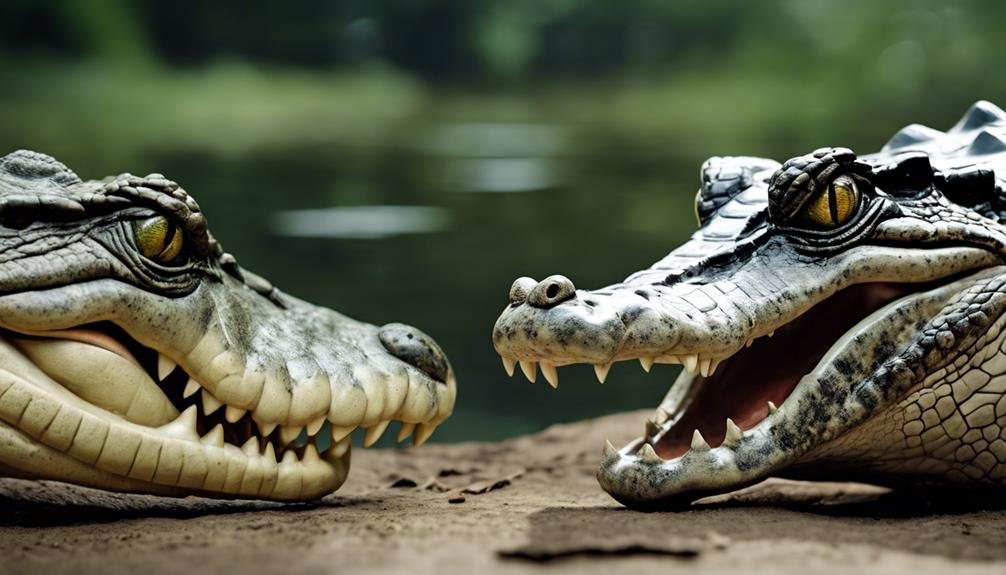You’ve likely seen them in zoos or documentaries, but can you tell an alligator from a crocodile? While they may look similar at a glance, several distinctive features set them apart. Consider their snouts; alligators sport a wider, U-shaped snout, suited for their typically marshy habitats, while crocodiles have a narrower, V-shaped snout, better for a predatory lifestyle in a range of watery environments. You might wonder, beyond just their snouts, what other factors distinguish these two? Stay tuned, and you’ll discover more about their behaviors, habitats, and even their surprising social lives.
Key Takeaways
- Alligators have a broad, U-shaped snout, while crocodiles have a narrow, V-shaped snout.
- Alligators’ lower teeth are not visible when the mouth is closed; crocodiles’ lower teeth are visible.
- Alligators primarily inhabit freshwater environments, whereas crocodiles can live in both freshwater and saltwater.
- Generally, crocodiles grow larger and are more aggressive than alligators.
- Crocodiles have special salt-filtering glands, allowing them to thrive in saltwater habitats.
Physical Characteristics
Alligators usually feature a broad, U-shaped snout, contrasting sharply with the narrow, V-shaped snout of crocodiles. This distinct snout shape not only influences their appearance but also affects their diet and hunting strategies. You’ll notice that, due to their U-shaped design, alligators are better suited to crushing prey, whereas the pointed snout of crocodiles is ideal for gripping and tearing.
When you see an alligator with its mouth closed, you’ll observe a neat overbite with no lower teeth visible, giving them a somewhat less menacing look compared to crocodiles. In contrast, crocodiles display some of their lower teeth even when their mouths are shut, due to their toothier grin which fits into grooves in their upper jaw. This difference isn’t just a trivial detail; it’s critical for recognizing these reptiles in the wild.
Coloration is another key difference. Alligators generally sport a darker, more uniform gray or black shade, blending well with the murkier waters of rivers and lakes. Crocodiles, on the other hand, tend to have a lighter, olive or tan color, better suited for camouflage in their typically sunnier, saltwater habitats.
Jawline Differences
Building on the distinct snout shapes, let’s explore how these differences extend to the jawlines of alligators and crocodiles. You’ll notice that the shape of the snout greatly impacts the appearance and function of their jaws.
- Snout Shape: Alligators have a broad, U-shaped snout that makes their jaw look wider and more robust. Crocodiles, however, sport a narrow, V-shaped snout, leading to a more streamlined and pointed jawline.
- Jaw Appearance: Due to their U-shaped snout, alligators’ jaws appear more rounded, while crocodiles, with their V-shaped snout, have a sharper, more angular jaw.
- Teeth Visibility: When alligators close their mouths, their upper jaws cover the lower teeth completely, giving them a tidy look. Crocodiles display some of their jagged lower teeth even when their mouths are shut, resembling a toothy grin.
- Overbite: Alligators exhibit an overbite; this means when their mouths are closed, the lower teeth fit snugly into the upper jaw and aren’t visible.
- Teeth Alignment: The alignment of teeth in crocodiles contributes to their fierce appearance, as the prominent lower teeth mesh with the gaps in the upper teeth.
These characteristics aren’t just cosmetic; they influence how each species interacts with their environment.
Size and Weight
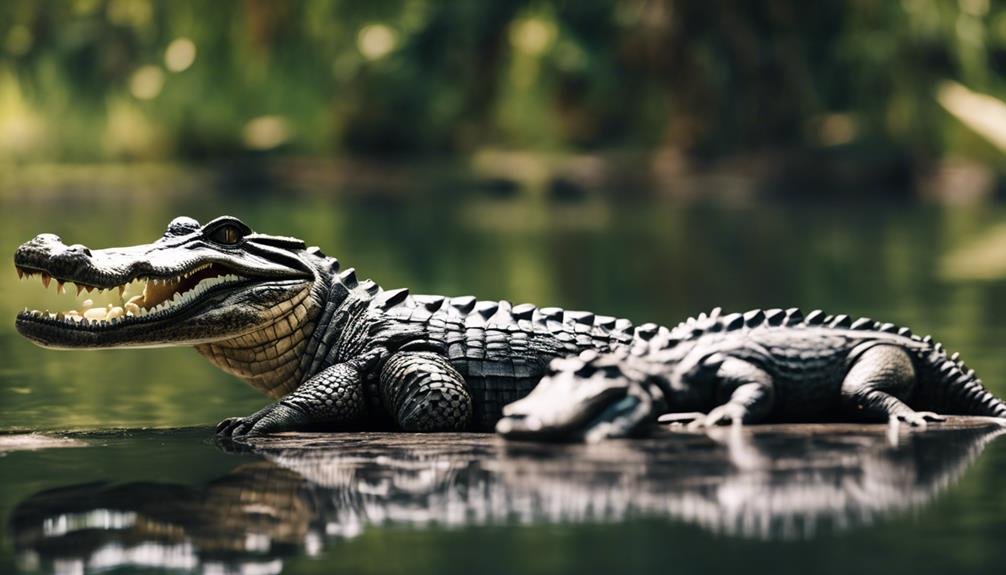

Considering the vast differences in size and weight, male crocodiles often outgrow alligators, reaching lengths of up to 20 feet. You’ll find that size and weight variation are important between these two reptiles, influenced by their genetics, habitat, and age. Female crocodiles generally measure between 8 to 12 feet, while female alligators typically cap at around 10 feet. This size difference is noticeable and essential when identifying these creatures in the wild.
Here’s a quick look at the size and weight differences:
| Species | Size (feet) |
|---|---|
| Male Alligator | 13-15 |
| Female Alligator | up to 10 |
| Male Crocodile | up to 20 |
| Female Crocodile | 8-12 |
And when it comes to weight:
| Species | Weight (pounds) |
|---|---|
| Alligator | 300-1,000 |
| Crocodile | 500-2,000+ |
As you can see, crocodiles can be significantly heavier than alligators. This size and weight advantage can be attributed to their broader geographic distribution and varied habitats, especially noticeable in regions like South Florida where alligators are generally smaller. Remember, the environment plays an important role in the size and weight of these reptiles.
Behavioral Traits
When comparing behavioral traits, you’ll notice crocodiles tend to be more aggressive than alligators, who generally exhibit more cautious behavior around humans. Crocodiles might even attack without provocation, making them more intimidating to encounter in the wild. In contrast, alligators are typically more timid compared to crocodiles and prefer to avoid human interaction unless they feel threatened or are provoked.
Here’s a quick rundown of their behavioral differences:
- Aggression: Crocodiles are notably more aggressive than alligators.
- Human Interaction: Alligators tend to be cautious and avoid humans, while crocodiles may attack unprovoked.
- Provocation Response: Alligators usually flee when disturbed, unless provoked into attacking.
- Danger to Humans: Crocodiles pose a greater threat to humans due to their aggressive nature.
- Feeding Behavior: Feeding alligators can cause them to lose their natural fear of humans, increasing the risk of attacks.
Understanding these traits helps you appreciate why it’s important to maintain a safe distance from these reptiles, especially in their natural habitats. Always respect their space and avoid interactions that could lead to aggressive responses.
Habitat Preferences
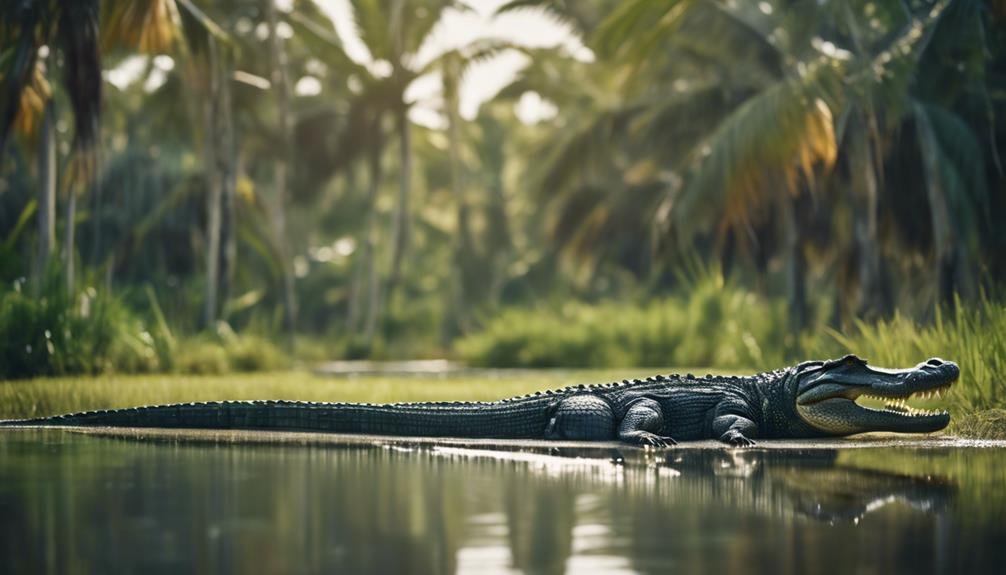

Alligators’ preference for freshwater habitats contrasts sharply with crocodiles, which thrive in both saltwater and freshwater environments. As you explore their world, you’ll notice this difference in habitat preferences plays an essential role in where you might encounter each species. While alligators prefer freshwater areas like marshes, lakes, and rivers, crocodiles have adapted to not only share these freshwater spots but also to dominate saltwater locales.
What’s especially fascinating is that crocodiles manage this versatility thanks to special glands that efficiently filter out salt, allowing them to inhabit saltwater environments comfortably. In contrast, alligators lack these glands, which restricts them primarily to freshwater settings. This distinction affects not only their geographical spread but also their daily life and survival strategies.
To give you a clearer picture of their preferred habitats, here’s a simple table:
| Species | Preferred Habitat |
|---|---|
| Alligator | Freshwater (lakes, rivers, swamps) |
| Crocodile | Both Saltwater and Freshwater |
This table highlights how crocodiles prefer saltwater and freshwater, showing a broader adaptability compared to the more freshwater-bound alligators. Understanding these preferences helps explain many aspects of their behavior and interactions within their ecosystems.
Geographical Distribution
Crocodiles boast a more extensive global presence than alligators, inhabiting diverse regions across Africa, Asia, the Americas, and Australia. This wide geographical distribution allows them to thrive in both freshwater habitats and saltwater environments. On the other hand, alligators have a more limited range. You’ll primarily find them in the southeastern United States and parts of China, where they stick closely to freshwater areas like rivers, lakes, and swamps.
Here’s a quick breakdown of their geographical spread:
- Alligators:
- Southeastern USA: Dominated by the American alligator
- China: Home to the lesser-known Chinese alligator
- Crocodiles:
- Africa: Includes the Nile crocodile along expansive river systems
- Asia: Home to several species, including the Saltwater and Mugger crocodiles
- The Americas: From the large American crocodile in South America to smaller species in Central America
- Australia: Dominated by the formidable Saltwater crocodile
Understanding the geographical distribution of these reptiles highlights how environment shapes their presence globally. While alligators are confined to specific freshwater regions, crocodiles display a remarkable adaptability, inhabiting a variety of climates and waters across continents.
Water Environment Adaptation
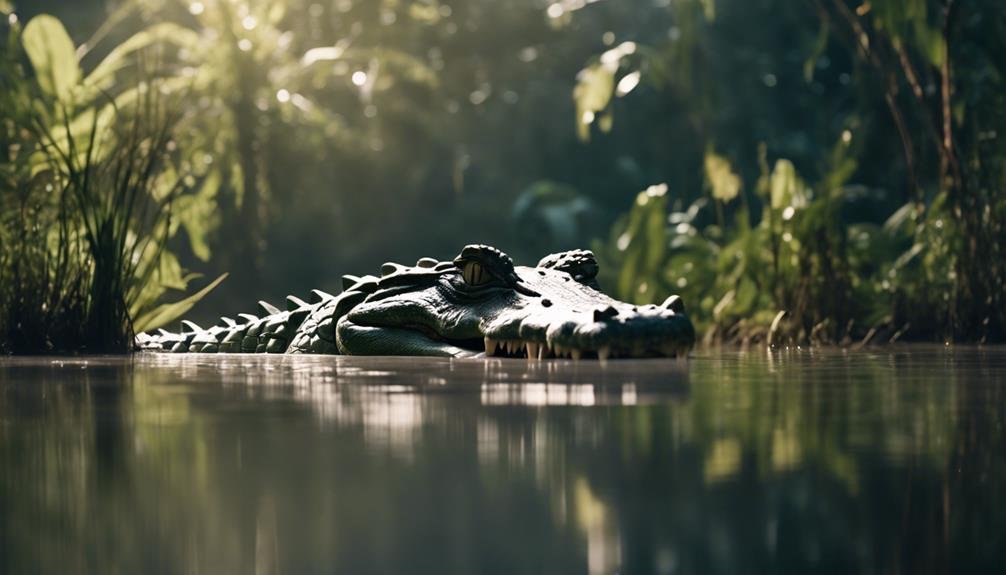

Adaptability plays an essential role in how crocodiles and alligators thrive in different aquatic environments. While you might think both these reptiles enjoy similar habitats, their tolerance for saltwater varies greatly.
Crocodiles have developed special glands that filter out excess salt, allowing them to inhabit both freshwater and saltwater environments. This unique adaptation lets them explore and dominate a variety of aquatic settings, including rivers, lakes, and saltwater habitats.
On the other hand, alligators display a preference for strictly freshwater environments. They’re primarily found in lakes, rivers, and swamps, steering clear of saltwater habitats. This limitation restricts their geographical spread compared to their crocodile cousins.
You’ll find that crocodiles’ ability to navigate and thrive in saltwater gives them a broader geographical distribution. This versatility in habitat adaptation shows why crocodiles can be found in more diverse locations around the world. Meanwhile, alligators depend heavily on freshwater sources, confining them to more specific regions where these conditions prevail.
Understanding these differences not only helps you distinguish between these two reptiles but also appreciate their unique adaptations to their environments.
Unique Abilities
Several unique abilities distinguish these remarkable reptiles, enhancing their survival in diverse environments. You’ll find that both alligators and crocodiles possess traits that not only allow them to dominate their habitats but also showcase their evolutionary prowess.
Here are some of the key abilities:
- Saltwater Crocodile’s Adaptability: Thriving in both saltwater and freshwater, the saltwater crocodile demonstrates incredible versatility. This species utilizes its lingual salt glands, a feature you won’t find in alligators, to excrete excess salt, allowing it to dominate coastal, brackish, and river environments.
- Lingual Salt Glands Efficiency: Crocodiles possess these specialized glands on their tongues, which help them manage large salt loads in saltwater environments, a clear advantage in saline-rich waters.
- Bite Force Superiority: When it comes to sheer power, crocodiles lead with a bite force that can reach up to 5,000 psi, particularly in the Nile crocodile. This extraordinary force isn’t just for feeding but also plays an important role in their defense and territorial disputes.
- Size Advantage: Crocodiles often outgrow alligators, with some reaching up to 19 feet in length, giving them a physical edge over their cousins.
- Behavioral Traits: While American crocodiles are considered more timid, this trait helps them avoid unnecessary confrontations, contrasting with other more aggressive crocodile species.
Do Alligators Have the Same Lifespan as Crocodiles?
Alligators and crocodiles have similar lifespans, with both species living for an average of 50-70 years in the wild. Factors such as habitat, food availability, and human interference can affect how long crocodiles live, but both alligators and crocodiles generally have similar lifespans.
Interesting Facts
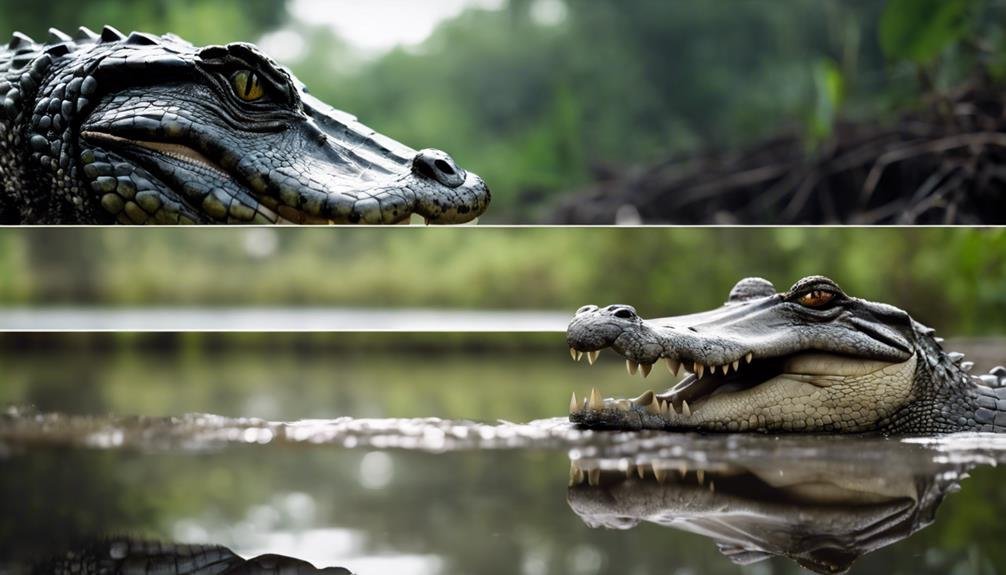

Delving into some captivating details, you’ll discover that alligators and crocodiles can be easily distinguished by the shape of their snouts. Alligators have a U-shaped snout that’s wider and shorter, while crocodiles sport a V-shaped snout, longer and pointed, ideal for catching fish.
Here’s a quick table to help you visualize some key differences:
| Feature | Alligator | Crocodile |
|---|---|---|
| Snout Shape | U-shaped | V-shaped |
| Habitat | Freshwater environments | Both freshwater and saltwater |
| Behavior | Timid and avoids humans | More aggressive |
| Salt Glands | Absent | Present on tongue |
| Location in the US | Primarily Southeastern states | Mainly in South Florida |
Alligators, while they might seem menacing, are generally more reserved around humans compared to their crocodile cousins. Remarkably, despite their fearsome reputation, fatalities from these creatures are exceptionally rare in the U.S., with an average annual fatality rate of just 0.3. This rarity highlights their typically non-aggressive nature unless provoked. So next time you’re near water in the Southeast, remember, you’re likely safe, but always stay cautious!
Conclusion
You can easily tell alligators and crocodiles apart if you know what to look for. Remember, alligators have a wider, U-shaped snout and hide their teeth when their mouth is closed, making them seem less fierce.
Crocodiles flaunt a narrow V-shaped snout and their teeth are always on display. They also differ in size, behavior, and preferred habitats.
Next time you’re near water bodies in their native regions, you’ll be better equipped to identify whether you’re spotting an alligator or a crocodile.

